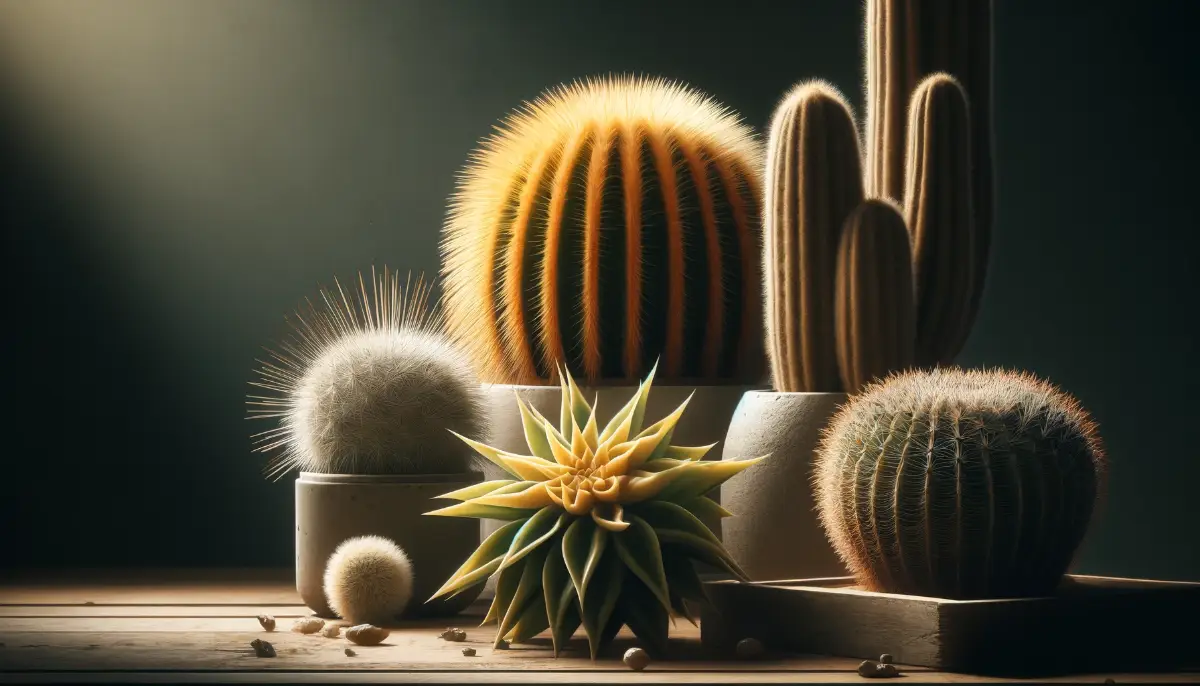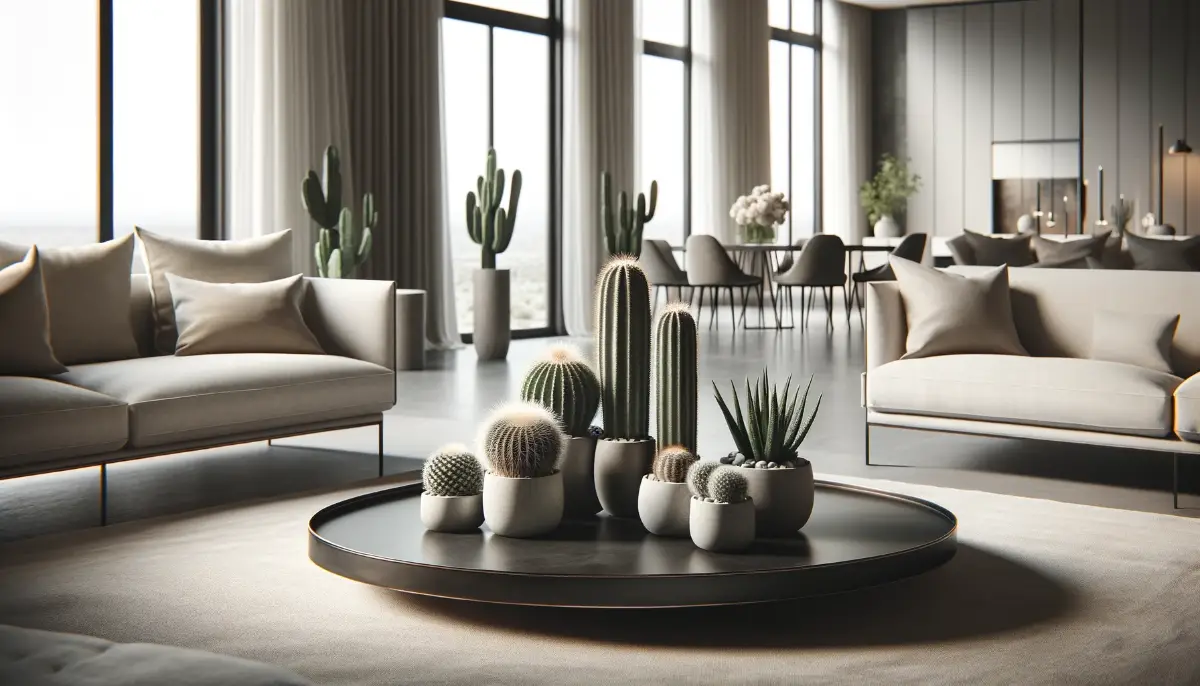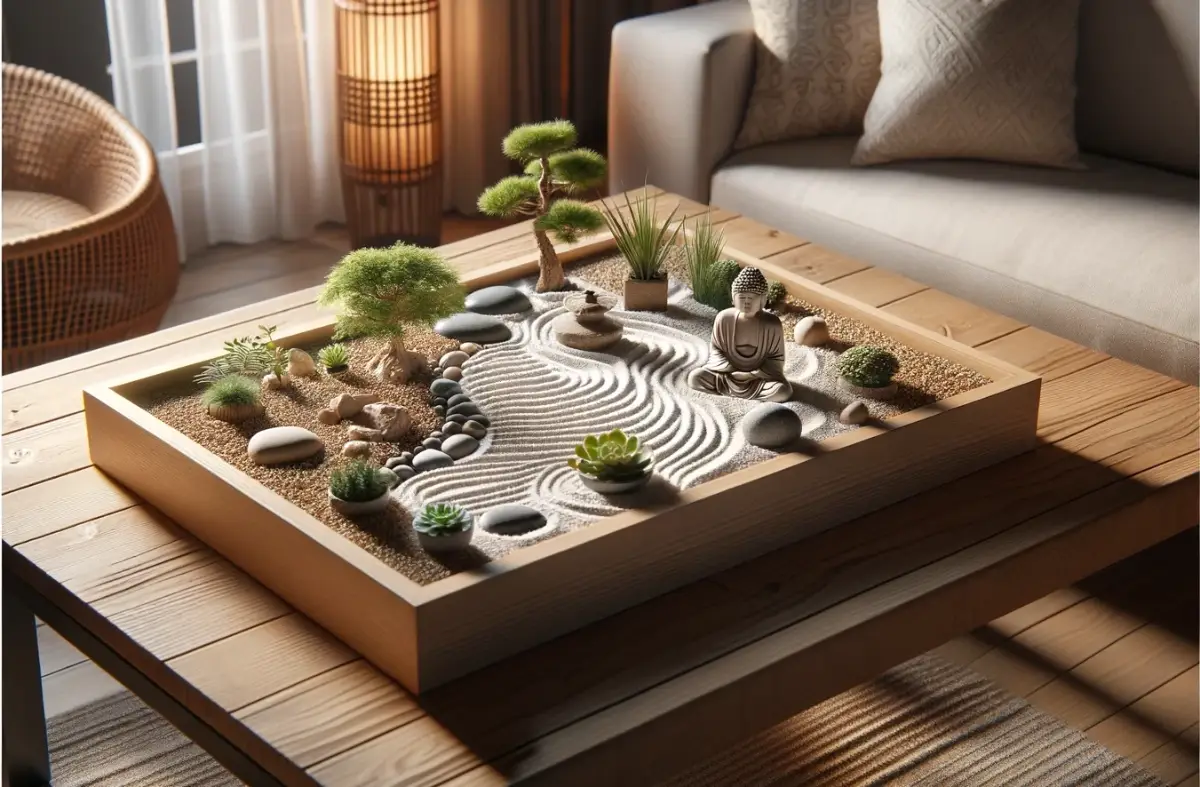Cacti, with their unique shapes and striking features, have become increasingly popular as indoor plants. Not only do they bring a touch of the exotic to our homes, but they are also celebrated for their low maintenance and adaptability to various indoor environments.
Integrating cacti into your home decor not only enhances the aesthetic appeal but also contributes to a healthier living space by improving air quality.
Creative Ideas for Arranging Indoor Cacti
Indoor cacti offer a striking complement to any home décor, thanks to their varied shapes, sizes, and colors. Whether you’re looking to create a serene green corner or a dramatic desert-themed display, cacti can be styled in numerous creative ways. Here are some ideas to help you arrange your indoor cacti in an eye-catching and practical manner.
Choosing the Right Cacti for Your Space
Selecting the right types of cacti is crucial for any indoor setting. Opt for species that thrive in indoor conditions such as low light and controlled temperatures.
Some popular choices include the Star cactus, Christmas cactus, and Bishop’s cap, which are known for their minimal care requirements and attractive appearances. Consider the size and growth patterns of the cacti to ensure they fit well in your available space.
Container and Potting Ideas
The choice of container can greatly enhance the appearance of your cacti. Consider pots that complement your interior design theme:
- Modern: Sleek geometric pots in neutral colors like black, white, or gray.
- Rustic: Natural terracotta pots or reclaimed wood planters.
- Minimalist: Clear glass containers or simple ceramic pots. Always ensure that your pots have good drainage to prevent water retention, which can harm the cacti.
Combinations of Cacti That Can Live Together
When designing a display of indoor cacti, combining species that share similar care needs but offer diverse appearances can create a visually striking and harmoniously thriving group. Here are some excellent combinations of cacti that can live together, enhancing both their health and your decor:
Desert Gems
- Golden Barrel Cactus (Echinocactus grusonii)
- Bishop’s Cap (Astrophytum myriostigma)
- Ladyfinger Cactus (Mammillaria elongata)
Care Needs: Full sunlight, infrequent watering, and well-draining soil.
Visual Appeal: The Golden Barrel provides a bold, spherical shape, complemented by the unique star-shaped Bishop’s Cap and the slender, clustered fingers of the Ladyfinger Cactus.
Textural Contrast
- Silver Torch Cactus (Cleistocactus strausii)
- Pincushion Cactus (Mammillaria)
- Blue Candle (Myrtillocactus geometrizans)
Care Needs: Bright, indirect light and moderate watering.
Visual Appeal: The tall, thin Silver Torch and Blue Candle offer vertical interest, while the Pincushion adds a burst of small, rounded textures, perfect for contrasting heights and shapes.
Colorful Collection
- Christmas Cactus (Schlumbergera)
- Moon Cactus (Gymnocalycium mihanovichii)
- Star Cactus (Astrophytum asterias)
Care Needs: Filtered light, regular watering, and high humidity.
Visual Appeal: The vibrant blooms of the Christmas Cactus, the colorful grafted top of the Moon Cactus, and the smooth, low-profile Star Cactus create a lively color palette.
Minimalist Mix
- Zebra Cactus (Haworthia fasciata)
- Prickly Pear (Opuntia)
- Snake Cactus (Echinopsis spachiana)
Care Needs: Medium to bright light, occasional watering.
Visual Appeal: The striking stripes of the Zebra Cactus, the broad, flat pads of the Prickly Pear, and the elongated form of the Snake Cactus offer a mix of forms and textures suited for a modern, minimalist aesthetic.
Sculptural Ensemble
- Saguaro Cactus (Carnegiea gigantea)
- Organ Pipe Cactus (Stenocereus thurberi)
- Fishhook Barrel Cactus (Ferocactus wislizeni)
Care Needs: Intense light, minimal watering, and hot conditions.
Visual Appeal: The iconic tall Saguaro, the multi-stemmed Organ Pipe, and the robust, hook-spined Barrel Cactus together mimic a natural desert landscape, creating a sculptural and dramatic display.
When combining different cacti, it’s crucial to ensure that their care requirements align, particularly regarding light, water, and soil conditions. This ensures that all plants in the arrangement thrive and grow healthily.
Grouping by Size, Shape, or Color for Visual Impact
One of the most effective ways to display indoor cacti is by carefully considering their arrangement in terms of size, shape, and color. This strategy not only enhances the visual appeal of your collection but also creates a cohesive look that can transform an ordinary room into a striking botanical showcase. Here’s how you can master the art of grouping cacti for maximum impact:
Grouping by Size
Arranging cacti by size helps in creating a balanced, layered look. Here’s how to do it effectively:
- Create Depth: Place larger cacti in the back of your display and smaller ones in the front. This setup gives a sense of depth and allows each plant to be visible.
- Vary Heights: Use stands or stacked books to elevate shorter cacti within a group, giving each plant its moment to shine without overshadowing smaller varieties.
Grouping by Shape
The unique shapes of cacti can be used to form interesting visual narratives in your home:
- Mix and Match: Combine spherical, columnar, and star-shaped cacti to provide contrast and interest. This variety breaks the monotony and keeps the eye moving.
- Symmetry vs. Asymmetry: Play with symmetrical arrangements for a more formal look or go for an asymmetrical setup for a casual, organic feel.
Grouping by Color
Color coordination can either calm or energize a space, depending on the hues you choose:
- Monochromatic Scheme: Grouping cacti with similar colors can create a subtle and sophisticated display. Greens of various shades can look particularly lush and vibrant.
- Contrasting Colors: For a more dynamic display, pair cacti with contrasting colors like green and purple, or green and yellow. This approach adds a pop of color and makes the arrangement stand out.
By using these grouping techniques, you can enhance the decorative impact of your indoor cacti, turning them into not just plants, but a key element of your home decor.
Utilizing Vertical Space with Hanging Pots and Shelves
Maximizing vertical space is an excellent strategy for displaying indoor cacti, especially in smaller living areas where floor space is limited. Using hanging pots and shelves not only helps save space but also adds a dynamic layer to your home decor. Here’s how you can effectively use vertical displays for your cacti collection:
Using Hanging Pots
Hanging pots can transform your cacti into floating pieces of art, creating a lively atmosphere:
- Choose the Right Pots: Opt for lightweight materials like plastic or woven baskets to ensure they can be safely hung. Ensure pots have good drainage to keep cacti healthy.
- Strategic Placement: Hang cacti near windows or in corners where they can get adequate light but are out of the way of daily activities. This placement prevents accidents and ensures the plants receive enough sunlight.
Installing Shelves
Shelves offer a stable platform for your cacti and provide ample opportunities to arrange them decoratively:
- Floating Shelves: Install floating shelves at different heights to create a tiered effect for displaying various types of cacti.
- Corner Shelves: Utilize corner space effectively with corner shelves, ideal for showcasing smaller cacti collections without consuming valuable room space.
Tips for Vertical Arrangements
- Safety First: Ensure all installations are secure to prevent accidents. This is particularly important in homes with children or pets.
- Accessibility for Maintenance: Arrange your cacti in a way that they remain accessible for watering and care. Avoid overly cramped arrangements which can hinder plant growth and health.
- Aesthetic Consideration: Consider the overall balance and visual appeal of your arrangement. Use a mix of plant sizes and pot styles to maintain interest and harmony.
By elevating your cacti, you not only make a unique style statement but also leverage the practical benefits of indoor gardening. Vertical arrangements are not just space-efficient but also allow you to enjoy your plants at eye level, adding a new dimension to your home’s ambiance.
Positioning Your Cacti for Optimal Health and Aesthetic Appeal
Positioning indoor cacti strategically within your home not only enhances their decorative impact but also is crucial for their health and growth. Here’s how to optimally position your cacti for both aesthetic value and plant health:
Maximizing Light Exposure
Cacti thrive in bright, indirect light. Here are some tips for positioning them to get adequate sunlight:
- Near Windows: Place cacti near south-facing windows where they can receive plenty of natural light throughout the day. Avoid direct sunlight that can scorch the plants.
- Light Levels: Different cacti have varying light requirements. Arrange them so that each species receives the right amount of light, adjusting positions with the changing seasons if necessary.
Enhancing Room Aesthetics
The placement of your cacti should complement the room’s layout and decor:
- Focal Points: Use larger or uniquely shaped cacti as natural focal points in a room. Position them where they will draw attention, such as on coffee tables or as part of a centerpiece.
- Symmetry and Asymmetry: Play with symmetrical arrangements for a more formal look or create an asymmetrical setup for a relaxed, organic feel. Consider the balance of the room and how the cacti can enhance its harmony.
Safety Considerations
Keeping cacti out of reach from children and pets is crucial, especially for varieties with sharp spines or toxic sap:
- Elevated Positions: Utilize high shelves or tall furniture where pets and young children cannot reach.
- Stable Surfaces: Ensure that cacti are placed on stable surfaces to prevent tipping, which could lead to injuries or spills.
Room Conditions
Apart from light, other environmental factors such as temperature and humidity play a role in the health of your cacti:
- Avoid Drafts: Keep cacti away from areas with cold drafts or excessive heat from radiators, which can stress the plants.
- Humidity Levels: Most cacti prefer lower humidity. Avoid placing them in kitchens, bathrooms, or other moist areas unless those conditions are suitable for a specific cactus variety.
By considering these factors, you can ensure your cacti not only look great but are also positioned in the optimal environment for their growth and well-being.
Handling and Safety Precautions for Indoor Cacti
While cacti are wonderful additions to home decor, they require careful handling, especially those with spines or potentially toxic sap. Understanding and respecting these traits is crucial for safely enjoying your indoor cacti. Here are some essential safety tips and precautions.
Handling Spiny Cacti
Cacti spines can vary significantly in size and sharpness, posing a risk of injury if not handled properly:
- Use Protective Gear: Always wear thick gardening gloves and use tongs or folded newspaper to handle spiny cacti during repotting or rearranging.
- Safe Placement: Position spiny cacti in areas where they won’t be accidentally brushed against, such as high shelves or centerpieces away from high-traffic areas.
Managing Cacti with Toxic Sap
Some cacti, such as certain Euphorbia species, contain sap that is irritating to the skin and eyes:
- Wear Safety Goggles and Gloves: These will protect you from accidental splashes when cutting or repotting these plants.
- First Aid: If sap comes into contact with skin or eyes, rinse immediately with plenty of water and seek medical advice if irritation persists.
Educating Family Members
Awareness is key to preventing accidents, especially in homes with children and pets:
- Teach Caution: Make sure family members, especially children, understand the risks associated with handling or touching cacti.
- Pet Safety: Ensure cacti are placed out of reach of pets, who might be tempted to bite or paw at them.
FAQs on Decorative Tips for Displaying Indoor Cacti
What are the best types of cacti for indoor decoration?
For indoor environments, look for cacti like the Christmas Cactus, Zebra Cactus, and Star Cactus, which thrive under indoor light conditions and add aesthetic value.
How often should I water my indoor cacti?
Watering frequency depends on the cactus type and environmental conditions, but a general rule is to water when the top inch of soil is dry. Overwintering cacti may need less frequent watering.
Can I put my cacti near a window?
Yes, cacti generally thrive near windows that provide plenty of bright, indirect sunlight. South-facing windows are usually ideal, but avoid direct sunlight that can scorch some types.
What are the best pots for indoor cacti?
Choose pots with drainage holes and opt for materials like terracotta or ceramic, which allow the soil to dry appropriately between waterings.
How can I safely handle spiny cacti?
Use gardening gloves and tools like tongs or a folded newspaper to manage and reposition spiny cacti without getting pricked.
What is the ideal soil mix for indoor cacti?
Use a well-draining cactus mix or create your own by combining regular potting soil with sand and perlite to ensure proper drainage and prevent root rot.
How do I choose the right location for my cacti in terms of home aesthetics?
Consider the overall décor theme of your home and use cacti as accent pieces. Position them as focal points on shelves, tables, or in clusters to enhance room aesthetics.
Can indoor cacti help improve air quality?
Yes, like many houseplants, cacti can help remove toxins from the air, although their effectiveness is generally lower compared to leafier plants.
What should I do if my cactus starts to look unhealthy?
Check for signs of overwatering or underwatering, ensure it’s getting enough light, and inspect for pests. Adjust care accordingly and consult a gardening expert if necessary.
Are there any pet-safe cacti?
While most cacti are not toxic, their spines can pose risks to curious pets. Opt for spineless varieties like the Christmas Cactus if pet safety is a concern.









